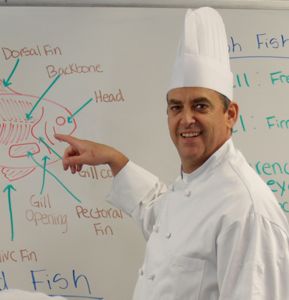“So we wrote this book with that ‘new’ instructor in mind, to provide him or her with a resource that they can refer to whenever needed. The content is valuable to all secondary and postsecondary culinary and hospitality instructors, from teaching assistants and first-year instructors on up to the seasoned veteran faculty member. What we did was take all of the latest relevant research and books out there on teaching, learning and pedagogy, and paired it with our own classroom and lab teaching experience. We then distilled it all down into a manageable, easy-to-read guide that any culinary or hospitality faculty member can just pick up no matter where they are in their career, go to a section, and get specific, practical information that can help them become better educators.
GMC:How would you describe the value that veteran educators like you can expect from this book?
Roche:“This must-have resource is filled with concrete, specific and actionable classroom and lab teaching techniques that any educator can start using immediately. It is a book about the tools of the craft of teaching and presents the very latest ideas, methods and strategies for secondary and college teaching, which is grounded in research and the best practices of faculty. This book provides both new and experienced faculty in multiple disciplines practical, tested strategies for addressing all the major aspects of secondary, college and university teaching, from planning a course through assigning final grades. We believe it is a compelling read for all culinary and hospitality educators who want to refresh or reexamine their classroom or lab practices.”
GMC: Can you share an example of a tip discussed in your book?
Roche:“Chapter 2 covers the ‘First Day of Class,’ which is often considered the most important day of the term for both students and faculty. This initial meeting serves to establish the class tone, as well as the rapport between the instructor and the students and among the students themselves. During this initial session it is important to allow time for both groups to share background information and future goals. Frequently the smallest of similarities among students can initiate a connection among them, which can further create a comfort level that allows for the sharing of ideas.
“The first part of the chapter covers student introductions and provides a tool called the ‘Student Information Sheet,’ which is a template that readers can customize as needed and use in their own classrooms to help get students to share their backgrounds. How to create a successful team environment is also covered in this chapter. Instructors should encourage students to get to know one another, because a sense of belonging is an important contributing factor in a college student’s academic success and retention. Therefore, help students make connections with classmates, such as encouraging them to set up study groups among themselves and exchange contact information such as cell-phone numbers and e-mail addresses so they can rely on one another as resources when the need exists.
“The introduction of an icebreaker activity on day one is another great way to help students establish bonds, and this chapter provides an example of an icebreaker activity that works well with both culinary and hospitality students.”
According to KendallHunt Publishing Company, Culinary Educators’ Teaching Tools & Tips is scheduled to release June 1, 2014, but might be available as early as Memorial Day. For more information or to purchase, visit www.kendallhunt.com/Roche_Ware.
“Successful educators constantly strive to improve their teaching styles throughout their teaching careers, and I sincerely hope that culinary and hospitality instructors from all over the world will use the ideas found within this book to inspire and help make their classrooms and labs even better than they currently are,” Roche says. “If a reader is new to teaching, then I also hope that this book can help smooth his or her first years as a culinary or hospitality educator.”
Brent T. Frei is editor of CAFÉ’s “The Gold Medal Classroom.”
 Due to release June 1, Culinary Educators’ Teaching Tools & Tips written by Colin P. Roche, Bradley J. Ware and Claudette Lévesque Ware is the first text of its kind.
Due to release June 1, Culinary Educators’ Teaching Tools & Tips written by Colin P. Roche, Bradley J. Ware and Claudette Lévesque Ware is the first text of its kind.